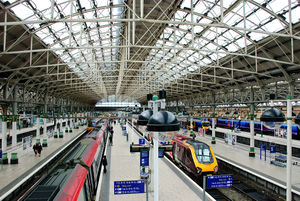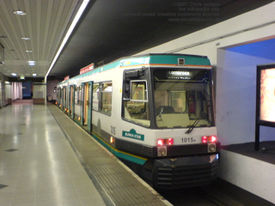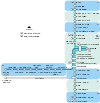Manchester Piccadilly station
| Manchester Piccadilly | |
|---|---|
 |
|
| Location | |
| Place | Manchester city centre |
| Local authority | City of Manchester |
| Operations | |
| Station code | MAN |
| Managed by | Network Rail |
| Platforms in use | 14 |
| Live arrivals/departures and station information from National Rail |
|
| Annual rail passenger usage | |
| 2004/05 * | |
| 2005/06 * | |
| 2006/07 * | |
| 2007/08 * | |
| 2008/09 * | |
| Passenger Transport Executive | |
| PTE | Greater Manchester |
| Zone | City (D) |
| History | |
| Opened 1842 | |
| National Rail - UK railway stations | |
| A B C D E F G H I J K L M N O P Q R S T U V W X Y Z | |
| * Annual passenger usage based on sales of tickets in stated financial year(s) which end or originate at Manchester Piccadilly from Office of Rail Regulation statistics. | |
Manchester Piccadilly is the principal railway station of Manchester in England. It serves intercity routes to London Euston, Birmingham New Street, South Wales, the south coast of England and Cornwall, Edinburgh and Glasgow Central in Scotland, and routes throughout northern England in addition to the Manchester Metrolink light rail system. One of 18 British railway stations managed by Network Rail, it is the largest and busiest of the five city centre railway stations in Central Manchester/Salford, the others being Manchester Victoria, Salford Central, Deansgate and Manchester Oxford Road.
Piccadilly is the second busiest railway station in the North of England and the fourth busiest in the United Kingdom outside London, after Birmingham New Street, Glasgow Central and Leeds.[1][2] According to Network Rail, which manages the station, over 28.5 million people use the station annually.[2]
According to an independent poll carried out in 2007, Manchester Piccadilly has the highest customer satisfaction level of any UK station, with 92% of passengers satisfied with the station; the national average was 60%.[3]
Contents |
History
The station was originally opened on 8 May 1842 and was initially known as Store Street station and as Bank Top station. It was the terminus of the Manchester and Birmingham Railway, who shared it from August 1844 with the Sheffield, Ashton-under-Lyne and Manchester Railway. It was renamed London Road station in 1847, around the time the Manchester, Sheffield and Lincolnshire Railway was formed (later to become the Great Central Railway). The Manchester, South Junction and Altrincham Railway (MSJAR) opened its line from Manchester Oxford Road station to London Road on 1 August 1849 and built its own platforms adjacent to the main part of the station. These platforms were from then on referred to as the MSJAR or South Junction platforms. During the early 1880s the whole of the station was enlarged. The MSJAR platforms and the bridge over Fairfield Street were demolished and the new island platform, on new girder bridges, was opened on 16 May 1882.
During the first two decades of the 20th century, London Road station was served by the London & North Western Railway, the Great Central Railway and through running powers, the North Staffordshire Railway. Following the 1923 railway grouping, the station was served by the London, Midland and Scottish Railway and the London and North Eastern Railway. Even after nationalisation in 1948, London Road station was operated as two independent sides, separated by formidable iron railings located where platform 5 now is. On one side was the London Midland Region of British Railways; on the other was the Eastern Region.
In 1910 a second nearby terminus, Mayfield station, was opened to cope with the huge volume of passengers. It was closed generally to passenger trains by 1952 but remained in use until August 1960 for "overflow" local services and also for one major passenger train, the Pines Express from Bournemouth to Manchester. It reopened as a parcels depot in 1970 but closed again. The long-disused building is visible across Fairfield Street from platforms 13 and 14.[4]
London Road station was renamed to its present name of Manchester Piccadilly when it was rebuilt and reopened on 12 September 1960 for the new London Midland Region electric train services to London. The MSJAR platforms and the bridges over Fairfield Street were replaced again at this time. The island platforms were built on top of a new pre-stressed concrete slab bridge with cantilevered sides for the tracks.
In the early 1970s, as part of the ill-fated Picc-Vic tunnel project, there were proposals to build an underground station, Piccadilly Low Level.[5] The project was eventually cancelled and subsequent rail improvements concentrated on surface projects and the introduction of light rail.
Piccadilly's island platforms were further rebuilt and lengthened in 1988 in connection with the opening of the Windsor Link. The glass roof over the terminal platforms was completely replaced in the late 1990s. The train shed is a Grade II listed building. In 2001-2002, as part of preparations for the 2002 Commonwealth Games the remainder of the station was rebuilt, to designs by BDP, greatly increasing the size of the station concourse and improving access for road traffic.
The station's undercroft (the two levels below the main rail platforms) has been converted to provide two platforms for the Manchester Metrolink tram system, which opened in 1992.
Description
National Rail station
The terminal part of the station consists of twelve platforms and generally service terminating/originating services with a longer stopover, while the busiest part of the station consists of platforms 13 and 14, the former MSJAR platforms, which are now used by through services via Manchester Oxford Road to North Wales, Liverpool, North-Western England, Glasgow and Edinburgh, including through services from Manchester Airport and split into a and b sections to allow more than one train to stand at a time. These through services tend to have much shorter linger times.
Facilities


The Fairfield Street entrance, at basement level, serves the car park, taxi rank, and the Manchester Metrolink station. Above, at track level, is a large modern concourse into which the main entrance from Piccadilly Approach feeds. It contains ticket offices, information points, seating, modern timetables, public toilets, shops and food and drink outlets. Above the concourse is a second level of food outlets and bars, together with the Virgin Trains First Class Lounge.
On the main concourse, glass doors within a large glass wall lead to platforms 1 to 12 in the main trainshed. A travelator leads to the upper concourse linked by footbridge, steps and lift to platforms 13 and 14. This island lounge contains further retail outlets, as well as customer toilets and a departure lounge with seating. There are also vending machines and two waiting areas/snack bars on platforms 13 and 14.
Manchester Piccadilly is fully accessible for disabled people, including (as well as static stairs), escalators and lifts to all levels, wide access doors and gates, Braille, and hearing loops throughout, as well as disabled toilet facilities.
Manchester Piccadilly handles about 1,000 train movements daily.
Cycle facilities are available at three places at Piccadilly - on Fairfield Street, the Long Stay Car Park and next to the Tower Block at the station front. All three have suffered thefts, but to address this, Manchester City Council and Network Rail unveiled plans in March 2010 for a 'Cycle Centre'. This will provide secure facilities, with maintenance and hire facilities also available. It is hoped this will open during the next financial year. A twin scheme was also unveiled by Salford Council, for the new MediaCityUK UK tram extension terminus. These schemes mirror the one announced for Leeds City railway station during 2009.
Manchester Metrolink station
| Manchester Metrolink | ||||||||||||||||||||||||||||||||||||||||||||||||||||||||||||||||||||||||||||||||||||||||||||||||||||||||||||||||||||||||
 |
||||||||||||||||||||||||||||||||||||||||||||||||||||||||||||||||||||||||||||||||||||||||||||||||||||||||||||||||||||||||
|---|---|---|---|---|---|---|---|---|---|---|---|---|---|---|---|---|---|---|---|---|---|---|---|---|---|---|---|---|---|---|---|---|---|---|---|---|---|---|---|---|---|---|---|---|---|---|---|---|---|---|---|---|---|---|---|---|---|---|---|---|---|---|---|---|---|---|---|---|---|---|---|---|---|---|---|---|---|---|---|---|---|---|---|---|---|---|---|---|---|---|---|---|---|---|---|---|---|---|---|---|---|---|---|---|---|---|---|---|---|---|---|---|---|---|---|---|---|---|---|---|
| Piccadilly Metrolink station | ||||||||||||||||||||||||||||||||||||||||||||||||||||||||||||||||||||||||||||||||||||||||||||||||||||||||||||||||||||||||
| Location | ||||||||||||||||||||||||||||||||||||||||||||||||||||||||||||||||||||||||||||||||||||||||||||||||||||||||||||||||||||||||
| Place | Manchester city centre | |||||||||||||||||||||||||||||||||||||||||||||||||||||||||||||||||||||||||||||||||||||||||||||||||||||||||||||||||||||||
| Local authority | Manchester | |||||||||||||||||||||||||||||||||||||||||||||||||||||||||||||||||||||||||||||||||||||||||||||||||||||||||||||||||||||||
| Fare zone information | ||||||||||||||||||||||||||||||||||||||||||||||||||||||||||||||||||||||||||||||||||||||||||||||||||||||||||||||||||||||||
| Metrolink Zone | D (City) | |||||||||||||||||||||||||||||||||||||||||||||||||||||||||||||||||||||||||||||||||||||||||||||||||||||||||||||||||||||||
| Conversion to Metrolink operation | 4 June 1992 | |||||||||||||||||||||||||||||||||||||||||||||||||||||||||||||||||||||||||||||||||||||||||||||||||||||||||||||||||||||||
|
||||||||||||||||||||||||||||||||||||||||||||||||||||||||||||||||||||||||||||||||||||||||||||||||||||||||||||||||||||||||
Manchester Piccadilly station is currently the terminus for Manchester Metrolink services to Bury, Altrincham, and Eccles. The Metrolink station, situated in a vaulted undercroft underneath the mainline station, is one of eight serving Manchester city centre, within the system's City Zone. Trams running from Piccadilly Gardens run down Aytoun Street, then cross onto London Road and run a short distance on segregated track, before crossing the road and entering the station undercroft through a tunnel entrance.
The station is the busiest on the Metrolink network. Under current arrangements, there are separate arrivals and departures platforms; after arrival passengers disembark, the empty tram runs into a reversing siding in a tunnel, where it reverses and runs up to the departure platform.[6] In earlier years a different arrangement was in place: one platform was used to handle all arrivals from Altrincham/departures to Bury, and the other platform was used for arrivals from Bury/departures to Altrincham and all services to/from Eccles, with a crossover built just outside the station to allow access to and from either platform.
The tram station has recently gone under a major refurbishment, and is the first to display the new Metrolink corporate identity which was unveiled in 2008.[7] Station signage now bears the yellow and silver livery which is to be applied to the new generation of trams from 2009.[8]
Future plans
Piccadilly is currently the eastern terminus of the Metrolink system, but the track was constructed with eastward extension in mind. Proposals have been approved to build a 6-mile extension to Ashton-under-Lyne.[9] The reversing sidings will eventually form part of this line which will run out of the north side of the station through Ancoats, Sportcity, Clayton, and along Ashton New Road to Droylsden and Audenshaw.[10] Trams terminating at Piccadilly from the city centre will use a new reversing siding being built to the east side of Sheffield Street.
In the early 1980s, original proposals for a light rail system were mostly based on converting existing railway lines to light rail operation (as with the Altrincham and Bury lines). Under these original plans, eastward extensions from Piccadilly would have involved running Metrolink trams along the Glossop Line (to Hadfield and Glossop) and along part of the Hope Valley Line (to Marple and Rose Hill). These plans are no longer being progressed however the alignment this route would use is still being protected as late as 2010 with BRB Residual land disposals being altered by the ORR after a year long consultation.
Images
 Piccadilly Metrolink stop. Refurbished in late 2009, it displays the new Metrolink brand identity. |
.jpg) The revised station signs at Piccadilly. |
 Mainline station exterior |
Virgin Trains British Rail Class 390 besides an Arriva British Rail Class 175 at Manchester Piccadilly station |
Services
Manchester Piccadilly is currently served by six train operating companies.
Northern Rail
- Local train services to stations in the Manchester area, primarily to destinations to the south and east of the city. These include Hadfield, Marple, Rose Hill Marple, New Mills Central, Sheffield via New Mills Central, Hazel Grove, Buxton, Crewe via Stockport or Manchester Airport, Stoke-on-Trent via Macclesfield, and Chester via Altrincham and Northwich
Services are also operated to the north and west of the city, via the towns to the north and west of Manchester to places such as Liverpool via St Helens Junction, Preston via Bolton and Southport via Wigan.
These are operated by a variety of trains of Class 142, Class 150 and Class 156 Sprinter DMUs, Class 180 or Class 323 electric units.
Arriva Trains Wales
- Hourly services via Chester and the North Wales Coast Line to Llandudno, calling at Manchester Oxford Road, Newton-le-Willows, Earlestown, Warrington Bank Quay, Runcorn East, Frodsham, Helsby, Chester, Shotton, Flint, Prestatyn, Rhyl,Abergele & Pensarn, Colwyn Bay, Llandudno Junction, Deganwy and Llandudno
- Hourly services via Shrewsbury and the Welsh Marches Line to Cardiff Central, with many services continuing to Carmarthen or Milford Haven. Class 175 Coradia units operate almost all of Arriva Trains Wales' services out of Manchester, with Class 158 and Class 150 units occasionally substituting.
CrossCountry
- Hourly services to Bournemouth, calling at Stockport, Macclesfield, Stoke-on-Trent, Stafford, Wolverhampton, Birmingham New Street, Birmingham International, Coventry, Leamington Spa, Banbury, Oxford, Reading, Basingstoke, Winchester, Southampton Airport (Parkway), Southampton Central, Brockenhurst and Bournemouth.
- Hourly services to Bristol Temple Meads, calling at Stockport, Stoke-on-Trent, Wolverhampton, Birmingham New Street, Cheltenham Spa, Bristol Parkway and Bristol Temple Meads some extended to Devon. All CrossCountry services operate using Voyager DMUs.
East Midlands Trains
- Hourly service from Liverpool Lime Street via Piccadilly to Sheffield and Nottingham, with most trains continuing to Norwich. Class 158 Express units are used for these services. Class 222 units are also occasionally used for additional capacity during times of special events.
First Transpennine Express operate services on three routes.
- The North TransPennine route sees a quarter-hourly service to Leeds via Huddersfield, with one train per hour continuing to each of Hull, Newcastle, Middlesbrough and Scarborough. In the opposite direction, one train per hour continues from Piccadilly to Liverpool Lime Street and two to Manchester Airport. A two-hourly service to Leeds and York operates after midnight, providing a 24-hour service.
- The South TransPennine route runs from Manchester Airport via Piccadilly to Sheffield and Cleethorpes, operating every hour.
- The TransPennine North West services run from Manchester Airport via Piccadilly to Preston via Bolton and Chorley every half hour, with trains continuing to Blackpool North every hour, and each of Barrow-in-Furness and Windermere every two hours, as well as continuing to Edinburgh Waverley and Glasgow Central, some of which are combined with services to Windermere, Blackpool North and Barrow-in-Furness.
Class 185 Desiro units now work the majority of services, replacing the class 158s on the North and South services, and the class 175s on the North West services. Most of the Manchester-Hull services are operated by Class 170 Turbostar units.
- Three trains per hour to London Euston via Stoke-on-Trent or Crewe as part of their West Coast franchise. These services are operated using Pendolino trains.


| Preceding station | Manchester Metrolink | Following station | ||
|---|---|---|---|---|
|
Piccadilly Gardens
towards Bury
|
Bury-Altrincham Line | Terminus | ||
| Terminus | Bury-Altrincham Line |
Piccadilly Gardens
towards Altrincham
|
||
| Eccles Line |
Piccadilly Gardens
towards Eccles
|
|||
| Proposed | ||||
| Terminus | Manchester-Ashton Line |
New Islington
towards Ashton
|
| Preceding station | Following station | |||
|---|---|---|---|---|
|
Stockport
|
Arriva Trains Wales
Welsh Marches Line
|
Terminus | ||
| Terminus | Arriva Trains Wales
Chester-Manchester Line
|
Manchester Oxford Road
|
||
|
Stockport
|
CrossCountry
Cross Country Network
|
Terminus | ||
|
Stockport
|
East Midlands Trains
Liverpool-Norwich
|
Manchester Oxford Road
|
||
|
Manchester Airport
|
First TransPennine Express
North TransPennine
|
Stalybridge
|
||
|
Manchester Oxford Road
|
||||
|
Heald Green
|
First TransPennine Express
TransPennine North West
|
Manchester Oxford Road
|
||
|
Mauldeth Road
|
First TransPennine Express
South TransPennine
|
Stockport
|
||
|
Levenshulme
|
Northern Rail
Buxton Line
|
Terminus | ||
|
Levenshulme
|
Northern Rail
Crewe-Manchester Line
|
Manchester Oxford Road
|
||
|
Ashburys
|
Northern Rail
Manchester-Glossop Line
|
Terminus | ||
|
Ardwick
|
Northern Rail
Hope Valley Line
|
|||
|
Stockport
|
||||
|
Levenshulme
|
Northern Rail
Mid-Cheshire Line
|
|||
|
Manchester Airport
|
Northern Rail
Liverpool-Manchester Line
|
Manchester Oxford Road
|
||
| Terminus | Northern Rail
Manchester-Preston Line
|
Manchester Oxford Road
|
||
|
Levenshulme
|
Northern Rail
Stafford-Manchester Line
|
Manchester Oxford Road
|
||
| Terminus | Northern Rail
Styal Line
|
Mauldeth Road
|
||
|
Stockport
|
Virgin Trains
West Coast Main Line
|
Terminus | ||
References
- ↑ Delta Rail (March 2010). "2008-09 station usage data" (pdf). Office of Rail Regulation. http://www.rail-reg.gov.uk/upload/xls/station_usage_0809.xls. Retrieved 2010-08-28.
- ↑ 2.0 2.1 "Footfall Figures" (pdf). Network Rail. p. 1. http://www.networkrail.co.uk/documents/5318_Footfall%20figures%20for%202007.pdf. Retrieved 2010-08-28.
- ↑ Revamped station tops train poll. BBC NEWS. 2 August 2007. http://news.bbc.co.uk/1/hi/england/manchester/6927406.stm. Retrieved 17 September 2008
- ↑ Sutcliffe, Paul; Catford, Nick. "Manchester Mayfield". Disused Stations: Closed Railway Stations in the UK (Disused Stations). http://www.subbrit.org.uk/sb-sites/stations/m/manchester_mayfield/index.shtml. Retrieved 17 September 2008
- ↑ SELNEC PTE (October 1971), SELNEC Picc-Vic Line, SELNEC PTE publicity brochure
- ↑ "Metrolink Tram Stops : Piccadilly". TheTrams.co.uk. http://www.thetrams.co.uk/metrolink/stops/Piccadilly. Retrieved 2009-07-09.
- ↑ "Work: a taster". Hemisphere Design and Marketing Consultants. 2008. http://www.hemispheredmc.com/work.html. Retrieved 2009-06-13.
- ↑ "Tram design on the right track". Manchester Evening News. 2008-10-14. http://www.manchestereveningnews.co.uk/news/business/s/1072244_tram_design_on_the_right_track. Retrieved 2009-01-31.
- ↑ "Metrolink Future Network". GMPTE. 2006. http://www.bbc.co.uk/manchester/travel/images/metrolink_map_2006.pdf. Retrieved 2008-12-28. - map of the proposed network expansion
- ↑ "Manchester Metrolink Extension Project, United Kingdom". Urban Transport Technology. http://www.urbantransport-technology.com/projects/manchester/. Retrieved 2009-07-09.
Unofficial Train timetable for Manchester Piccadilly
External links
- Station information on Manchester Piccadilly station from Network Rail
| Manchester Lines - City Centre and North, (Past, Present and Future) | |||||||||||||||||||||||||||||||||||||||||||||||||||||||||||||||||||||||||||||||||||||||||||||||||||||||||||||||||||||||||||||||||||||||||||||||||||||||||||||||||||||||||||||||||||||||||||||||||||||||||||||||||||||||||||||||||||||||||||||||||||||||||||||||||||||||||||||||||||||||||||||||||||||||||||||||||||||||||||||||||||||||||||||||||||||||||||||||||||||||||||||||||||||||||||||||||||||||||||||||||||||||||
|---|---|---|---|---|---|---|---|---|---|---|---|---|---|---|---|---|---|---|---|---|---|---|---|---|---|---|---|---|---|---|---|---|---|---|---|---|---|---|---|---|---|---|---|---|---|---|---|---|---|---|---|---|---|---|---|---|---|---|---|---|---|---|---|---|---|---|---|---|---|---|---|---|---|---|---|---|---|---|---|---|---|---|---|---|---|---|---|---|---|---|---|---|---|---|---|---|---|---|---|---|---|---|---|---|---|---|---|---|---|---|---|---|---|---|---|---|---|---|---|---|---|---|---|---|---|---|---|---|---|---|---|---|---|---|---|---|---|---|---|---|---|---|---|---|---|---|---|---|---|---|---|---|---|---|---|---|---|---|---|---|---|---|---|---|---|---|---|---|---|---|---|---|---|---|---|---|---|---|---|---|---|---|---|---|---|---|---|---|---|---|---|---|---|---|---|---|---|---|---|---|---|---|---|---|---|---|---|---|---|---|---|---|---|---|---|---|---|---|---|---|---|---|---|---|---|---|---|---|---|---|---|---|---|---|---|---|---|---|---|---|---|---|---|---|---|---|---|---|---|---|---|---|---|---|---|---|---|---|---|---|---|---|---|---|---|---|---|---|---|---|---|---|---|---|---|---|---|---|---|---|---|---|---|---|---|---|---|---|---|---|---|---|---|---|---|---|---|---|---|---|---|---|---|---|---|---|---|---|---|---|---|---|---|---|---|---|---|---|---|---|---|---|---|---|---|---|---|---|---|---|---|---|---|---|---|---|---|---|---|---|---|---|---|---|---|---|---|---|---|---|---|---|---|---|---|---|---|---|---|---|---|---|---|---|---|---|---|---|---|---|---|---|---|---|---|---|---|---|---|---|---|---|---|---|---|---|---|---|---|---|---|---|---|---|---|---|---|---|---|---|---|---|---|---|---|---|---|---|---|
|
|||||||||||||||||||||||||||||||||||||||||||||||||||||||||||||||||||||||||||||||||||||||||||||||||||||||||||||||||||||||||||||||||||||||||||||||||||||||||||||||||||||||||||||||||||||||||||||||||||||||||||||||||||||||||||||||||||||||||||||||||||||||||||||||||||||||||||||||||||||||||||||||||||||||||||||||||||||||||||||||||||||||||||||||||||||||||||||||||||||||||||||||||||||||||||||||||||||||||||||||||||||||||
|
||||||||||||||||||||||||||
|
|||||||||||||||||
|
|||||||||||||||||||||||||||||||||||
|
||||||||||||||||||||||||||||||||||||||||||||||||||||||||||

